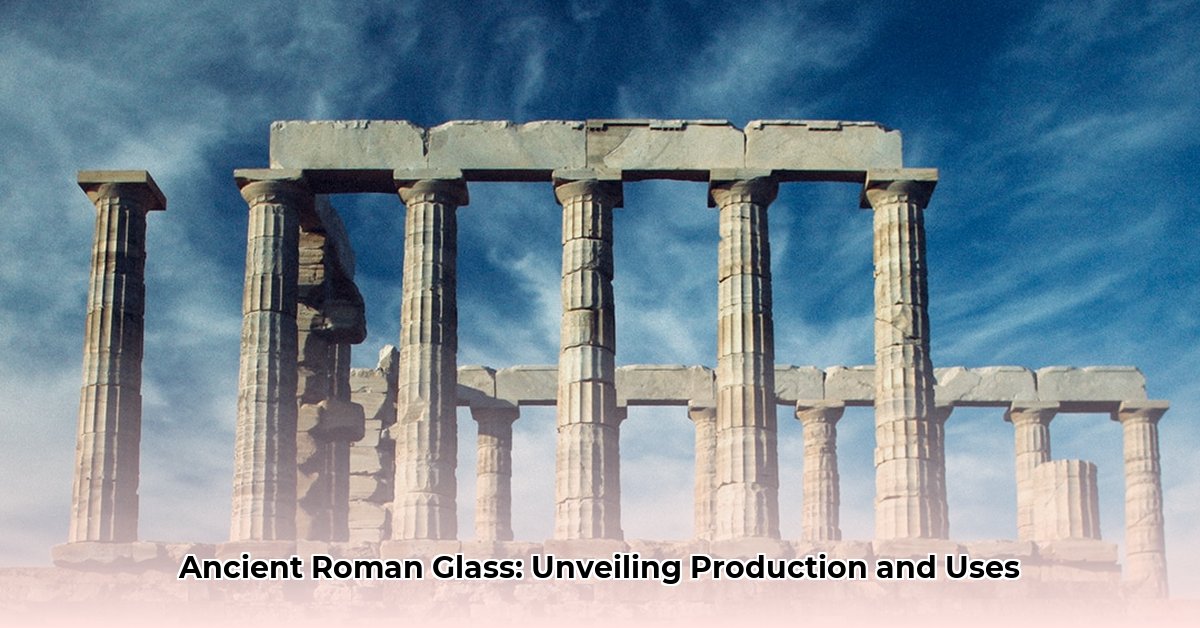Imagine a world where glass, this seemingly ordinary material we encounter daily, was once a marvel, almost magical. We’re surrounded by it, from windows to bottles, yet its ancient story is far from mundane. This deep dive into ancient Roman glass offers a backstage pass to a transformative technology, revealing its humble origins, the revolutionary impact of glassblowing, and its surprising versatility. Explore more about Roman artifacts for further insight. How did glass transcend its initial role as a luxury, becoming integral to Roman society and hinting at a sophisticated circular economy that continues to fascinate archaeologists and historians today? Let’s uncover the secrets of a material that mirrored the Roman Empire’s own rise to power and influence.
From Precious Rarity to Commonplace Utility: The Transformative Journey of Roman Glassware
For centuries before the Romans truly embraced glass, it was an exclusive commodity. Early pieces, crafted using time-consuming Hellenistic methods like core-forming and casting, were typically thick-walled, often opaque, and available only to the wealthiest citizens. These labor-intensive processes, frequently involving wrapping molten glass around a temporary clay or mud core, ensured glass remained a rare, high-value item, much like precious metals. Acquiring a delicate glass vessel signified immense status within Roman society, a testament to its scarcity and the intricate craftsmanship required. Initially, the Roman craft was a relatively minor one during the Republican period, with products primarily imitating Hellenistic styles and techniques.
Then, a revolution occurred. Around the 1st century AD, an ingenuity that changed everything emerged from the Near East—likely in Syria or Palestine, though the exact origin remains debated. The invention of glassblowing dramatically altered production, allowing skilled artisans, known as vitriarii, to create thinner, more translucent, and remarkably complex forms with unprecedented speed and efficiency. This innovation democratized glass, making it accessible to a broader segment of society. Suddenly, delicate goblets, sturdy jars, and practical bottles became commonplace. As Strabo noted in his Geographica (XVI.2), by the mid-1st century AD, “a [glass] drinking cup could be bought for a copper coin,” illustrating its widespread availability. This shift also fostered a division of labor: primary glassmakers fused raw materials, while glassworkers skillfully shaped the molten glass. This specialization, coupled with the stability and expanding trade under Emperor Augustus and the subsequent Pax Romana, propelled the burgeoning glass industry into an era of significant growth, ensuring its widespread diffusion across the Roman Empire and beyond, reaching as far as the Kushan Empire in Afghanistan and India, and even the Han Empire of China.
The Alchemical Art: Raw Materials and Production Techniques of Roman Glassmaking
The core ingredients for ancient Roman glassmaking were deceptively simple: silica (primarily sand), soda (a flux, almost exclusively natron in the Roman period), and lime (a stabilizer). Yet, the Romans understood that the purity and specific ratios of these components were paramount for quality. Just as a baker knows the importance of precise measurements, Roman glassmakers meticulously sourced their raw materials. For instance, the sands from the Belarus River in Phoenicia and the Volturnus River in Campania were highly prized due to their natural richness in lime, a crucial element for glass durability and resistance to water damage. The primary source of natron was Wadi El Natrun in Egypt, influencing the geographical siting of large-scale raw glass production workshops.
The production process was typically divided. Primary glassmaking involved using massive furnaces heated to approximately 1100°C (2012°F) to fuse the raw ingredients into large, unshaped chunks of raw glass, often referred to as ‘slag.’ Evidence from places like Bet She’arim, where an 8-tonne glass slab was recovered, indicates the immense scale of these operations. These raw glass chunks were then traded across the empire to secondary workshops where glassworkers would re-melt the material at lower temperatures, typically around 750°C (1382°F), to make it pliable enough for shaping.
Beyond clarity, the Romans were masters of color. By carefully introducing metallic oxides during the melting process, they could achieve a dazzling array of hues:
| Colourant | Primary Source/Component | Effect |
|---|---|---|
| ‘Aqua’ (Pale Blue-Green) | Iron(II) oxide (FeO) | The common natural color of untreated glass. Many early Roman vessels exhibited this shade. |
| Colourless | Antimony or Manganese oxide | Produced by oxidizing the inherent Iron(II) oxide to Iron(III) oxide, which is a much weaker colorant. Manganese as a decolorant was a Roman invention, largely replacing antimony, though antimony continued to be used for more truly colorless glass, particularly in Italy and northern Europe. |
| Amber | Iron–sulfur compounds | Typically resulted from sulfur contaminants in natron under reducing furnace conditions. |
| Purple | Manganese (e.g., pyrolusite) | Intensive purple hues achieved with higher concentrations of manganese under oxidizing conditions. |
| Blue and Green | Copper | Added for translucent blues moving towards darker greens. Derived from oxide scale of scrap copper to avoid mineral contaminants. |
| Dark Green | Lead | Used in conjunction with copper to deepen green shades. |
| Royal Blue to Navy | Cobalt | Even small amounts (0.1%) produced intense blue coloration. |
| Opaque Red to Brown (Pliny’s haematinum) | Copper, Lead | Under strongly reducing conditions, copper precipitates as cuprous oxide. Lead enhances precipitation and brilliance, creating a blood-red to brown opaque glass. A rare but technically sophisticated color. |
| White | Antimony (e.g., stibnite) | Antimony reacts with lime to form calcium antimonite crystals, creating high opacity. |
| Yellow | Antimony and Lead (e.g., bindheimite) | Precipitation of lead pyroantimonate results in an opaque yellow. Often used in mosaic and polychrome pieces. |
This nuanced understanding of chemistry—transforming mundane sand into shimmering, colored artifacts—highlights the advanced technical knowledge possessed by Roman artisans.
Beyond the Vessel: Diverse Applications and Lasting Value
The utility of ancient Roman glass extended far beyond simple containers. Its versatility allowed it to integrate into numerous aspects of Roman life, from the mundane to the magnificent. Glass tesserae brought vibrant color and reflective surfaces to intricate mosaics on floors and walls, enriching public baths and private villas. Rather than just decorative, glass also served practical purposes as window panes. Early panes were rough cast into wooden frames, but from the late 3rd century AD onwards, window glass was made by the muff process, where a blown cylinder was cut laterally and flattened out to produce a sheet, allowing more light into homes and public buildings.
Affluent Romans adorned themselves with exquisite glass jewelry, showcasing its aesthetic appeal in beads, rings, and bracelets. Notably, engravers cut glass to replicate the carved gems found in rings, demonstrating its versatility as a material. Surprisingly, glass even entered the realm of medicine, with some beliefs attributing healing properties to certain glass types, and in powdered form, it was reportedly used as a medicine and even toothpaste. Glass bottles like alabastra and unguentaria held perfumes, oils, and cosmetics, while larger amphoriskoi were used by merchants to ship food and drink across the empire. The presence of Roman glass in Afghanistan, India, and China underscores the empire’s vast trade networks.
The economic value of Roman glass varied considerably. A simple, mass-produced vessel might have been an everyday item, affordable to many, as Strabo attested. However, a meticulously crafted, intricate piece with rare coloring or complex decorative work could command prices rivaling those of precious metals, sometimes even surpassing them. Colorless glass, resembling natural rock crystal, was particularly esteemed, reflecting the technical mastery required to achieve such purity. Pliny the Elder, in his Natural History (36, 198), states that “the most highly valued glass is colourless and transparent, as closely as possible resembling rock crystal,” indicating a clear preference for transparency over strong colors, especially from around 70 AD onwards. It’s fascinating to consider how a material that started as a rare luxury transitioned to such widespread use, a testament to its evolving production methods and profound social impact.
Artistic Peaks and Shifting Centers: The Evolution of Roman Glass Styles and Techniques
The artistry of ancient Roman glass reached its zenith in the 4th century AD, exemplified by the ethereal “cage cups” (diatreta). These remarkable vessels featured intricate, three-dimensional designs that appeared to float free from the main body of the cup, connected only by tiny, almost invisible glass bridges. The Lycurgus Cup, housed in the British Museum, is a prime example of this advanced technique, showcasing dichroic glass that astonishingly changes color depending on the light source—appearing green in reflected light and red when illuminated from behind, a marvel of ancient nanotechnology involving colloidal gold and silver particles. This level of craftsmanship underscores the profound skill and ingenuity of Roman glassmakers (diatretarii, or glass-cutters). Other luxury glasses included figure vessels, snake thread glasses, and extensively cut glassware, often competing with silver and gold as elite tableware.
Beyond the revolutionary glassblowing, Roman artisans employed a rich array of decorative techniques:
- Core-Forming: An early technique (popular in 1st century BC) where a mud and straw core on a metal rod was dipped in molten glass or trailed with liquid glass.
- Casting and Slumping: Used for thicker vessels and mosaic pieces, where glass was melted and shaped within molds or slumped over forms. This evolved into modern caneworking and millefiori techniques. Common patterns included floral (millefiori), spiral, marbled, dappled, lace, and striped designs, often imitating natural stones like sardonyx. Pillar-moulded bowls are a prime example.
- Mould-Blowing: Appearing in the second quarter of the 1st century AD, this allowed for mass production of relief patterns by blowing glass into carved molds.
- Cutting and Engraving: Techniques borrowed from gem-cutting, used to create intricate designs, cameos (e.g., the Portland Vase, depicting the marriage of Peleus and Thetis), and later, the complex cage cups.
- Applied Decoration: Hot trails of glass or small glass drops (like the “Cologne nubs”) of a different color were applied to the vessel’s surface. Handles were usually added separately.
- Gold Sandwich Glass: A layer of gold leaf with a design was encased between two fused layers of glass. Most famous are the 4th-century funerary roundels for catacomb graves in Rome, though superb 3rd-century portrait levels also exist.
As the vast Roman Empire expanded and diversified, so too did its glass production, leading to the emergence of distinct regional styles. These variations reflected indigenous cultural influences and local material availability. For instance, the Rhineland and northern France developed distinctive forms not seen further south. Cologne became a major glassworking center, and the Romano-Germanic Museum now boasts the world’s largest collection of Roman glass, with over 4,000 complete pieces. Italian workshops remained important, especially for brightly colored vessels, initially dominating but then facing competition from eastern centers. Following Emperor Constantine’s pivotal decision to relocate the imperial capital to Constantinople in 330 AD, a gradual but significant shift in glass production occurred. This move, coupled with tax exemptions granted to glassworkers who joined him, saw the long-standing dominance of Italian workshops wane as new centers of excellence blossomed in the East, solidifying the global reach and adaptive nature of the Roman glass industry.
The Roman Circular Economy: Ingenious Recycling and Resource Management
The Romans, surprisingly, were pioneers in recycling, particularly with glass. This ancient practice, driven by both ingenuity and necessity, represents an early model of a circular economy. Primary glass production concentrated in regions like Egypt and Syria where natron and fuel were abundant. However, post-glassblowing, demand for clear glass surged, fostering localized recycling across the empire, especially in the western provinces. Literary sources like Statius and Martial attest to the importance of glass recycling, supported by archaeological evidence showing a scarcity of large glass fragments at domestic sites, suggesting they were collected. In Roman Britain, for example, 3rd and 4th century AD finds strongly indicate widespread glass recycling, driven by raw material shortages in distant imperial outposts.
The process, while not explicitly documented in surviving manuals, can be inferred from archaeological findings:
- Collection: Discarded glass from households, workshops, and construction sites was gathered.
- Sorting (Likely): Glass was probably sorted, at least by color, given the high value placed on colorless glass.
- Crushing: Fragments were crushed into smaller pieces, known as cullet, to facilitate easier melting.
- Melting: The cullet was re-melted in furnaces. This required significantly lower temperatures than fusing raw materials, representing an economically significant fuel saving (a major concern given deforestation).
- Shaping: The molten recycled glass was then skillfully shaped into new objects using established techniques like glassblowing or casting.
- Distribution: These newly formed recycled products were then distributed throughout the empire, reaching diverse markets.
This practice of adding cullet to new batches not only lowered melting temperatures but also improved the final product’s consistency and quality, a remarkably resourceful efficiency. Repeated recycling is compositionally visible via elevated levels of certain metals used as colorants, acting as an archaeological fingerprint.
Production Challenges and Enduring Mysteries
While innovative, Roman glass production was not without its drawbacks, particularly concerning environmental and human welfare. The immense heat required for primary glassmaking meant extensive deforestation for kiln fuel, leading to habitat destruction and resource depletion. The workshops themselves posed significant occupational hazards, including burns, exposure to extreme heat, and potential lung damage from inhaling fine silica dust and fumes. These conditions likely led to injuries, chronic respiratory illnesses, and reduced life expectancy for glassworkers. Economically, the industry’s dependence on specific raw material sources, like Egyptian natron, created supply chain vulnerabilities and could lead to market volatility.
Despite extensive research, some aspects of Roman glassmaking remain debated. The precise reasons for the shift from antimony to manganese as a decolorizing agent are not fully understood, though cost, availability, and effectiveness likely played roles. The exact geographical locations of all major raw glass production centers, beyond general regions like the eastern Mediterranean, are still unclear due to scarce archaeological evidence. Similarly, how some of the most complex pieces like the cage cups were manufactured continues to be a subject of intense scholarly debate. These lingering questions continue to fuel new discoveries and research, ensuring that the fascinating history of ancient Roman glass remains a vibrant field of study.
In conclusion, ancient Roman glass is far more than just a historical artifact; it’s a testament to incredible ingenuity, economic adaptability, and profound cultural impact. Its evolution from a rare luxury to an everyday staple, its sophisticated production methods, and its early circular economy practices offer a fascinating glimpse into the Roman world’s technological prowess and its enduring legacy, a legacy that continues to resonate in modern glassmaking traditions, notably inspiring later centers of excellence like Venice. The shattered fragments of Roman glass tell a story not just of beauty and craftsmanship, but of an empire’s innovation and resourcefulness.










